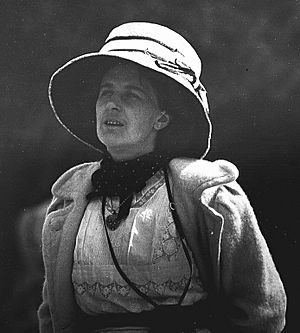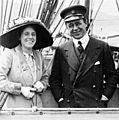Kathleen Scott facts for kids
Quick facts for kids
The Lady Kennet
FRBS
|
|
|---|---|

Scott in 1910
|
|
| Born |
Edith Agnes Kathleen Bruce
27 March 1878 Carlton in Lindrick, Nottinghamshire, England
|
| Died | 25 July 1947 (aged 69) London, England
|
| Alma mater |
|
| Spouse(s) |
Edward Hilton Young
(m. 1922) |
Kathleen Scott (born Edith Agnes Kathleen Bruce, later Young, Baroness Kennet; 27 March 1878 – 25 July 1947) was a famous British sculptor. She created many sculptures, especially busts (head and shoulders) and large public monuments. She is well-known for her statues of her first husband, the Antarctic explorer Captain Robert Falcon Scott.
Kathleen Scott was considered a very important and busy British woman sculptor before Barbara Hepworth. She preferred a traditional style of art. She was also the mother of Sir Peter Scott, a painter and naturalist, and Wayland Young, a writer and politician.
Contents
Biography
Early Life and Education
Kathleen Scott was born in Carlton in Lindrick, Nottinghamshire, England, on March 27, 1878. She was the youngest of eleven children. Her father was a Church of England clergyman. Sadly, she became an orphan by the age of eight.
She was then raised by a relative in Edinburgh, Scotland. She attended St George's School there. Later, she went to boarding schools in England, including a convent school.
Art Studies in Paris
Kathleen studied art at the Slade School of Fine Art in London from 1900 to 1902. After that, she moved to Paris with two friends from Slade. There, she joined the Académie Colarossi, focusing on sculpture.
Within three months, one of her statuettes (small statues) was accepted into the famous Paris Salon art show. It even won a medal! She became friends with the famous sculptor Auguste Rodin. He mentored her and allowed her to visit his studio often. In Paris, she also met other famous artists and writers.
In 1903, Kathleen joined a relief mission to Macedonia to help people after a conflict. She helped with supplies and basic nursing. She became very ill there but recovered. After traveling for a while, she returned to Paris to continue her sculpture work.
Marriage to Robert Falcon Scott
In London, Kathleen set up her studio and created many portrait busts of young men. She met Captain Robert Falcon Scott in October 1907. He was a famous Antarctic explorer. They quickly decided to marry.
Their wedding took place on September 2, 1908, at Hampton Court Palace. Many important guests attended, including Auguste Rodin. They had a son named Peter Scott, who later became famous for painting and conservation.
In 1910, Kathleen traveled to New Zealand to see her husband off on his journey to the South Pole. She returned to England in 1911. While her husband was away, she continued her sculpting. She made portrait busts of friends and family.
She also received her first major public art job: a life-size statue of Charles Rolls. This statue was unveiled in April 1912. She also created busts of important figures like the Prime Minister Herbert Asquith.
In early 1913, Kathleen decided to travel to New Zealand to meet her husband. However, news reached her ship that Captain Scott and his team had died in Antarctica. She continued her journey to New Zealand, where she received his diaries and letters.
Back in London, Kathleen and her son received a lot of public attention. She focused on her work to cope. She began creating large statues of Captain Scott and other important people. Before World War I began, she also traveled to Andorra and North Africa.
World War I Contributions

During World War I, Kathleen paused her sculpture work to help with the war effort. She helped set up an ambulance service for the French army. She also raised money and recruited volunteers for a hospital in France, where she worked for a time.
Later, she worked in a factory assembling electronics. Even during the war, she continued to create statues related to her husband's expedition. She made a statue of Edward Wilson in 1914. She also created two bronze statues of Captain Scott, unveiled in 1915.
In 1916, she traveled to Italy to carve a white marble statue of Captain Scott. This statue was later placed in Christchurch, New Zealand, in 1917. In 1918, Kathleen worked at a hospital in Sidcup. She made masks and facial models for plastic surgeons to help wounded soldiers.
The 1920s and Beyond
After the war, Kathleen continued to be a very busy sculptor. She received many requests for portraits and war memorials. Her work was shown at the Royal Academy in London almost every year between 1920 and 1940. She also had six big solo art shows.
In 1921, she took a long trip through the United States, Panama, Cuba, and Ecuador. During this time, she created a large portrait bust of David Lloyd George, who was Prime Minister. She also made the Thinking Soldier war memorial for Huntingdon.
One of her sculptures, a figure of a young man, was shown at the Paris Salon in 1925 and won a medal. This statue, now called May Eternal Light Shine Upon Them, is a memorial to the Antarctic Expedition. It stands at the Scott Polar Research Institute in Cambridge.
In November 1919, Kathleen met Edward Hilton Young, a Member of Parliament (M.P.). They married in March 1922. Their second son, Wayland Hilton Young, was born the next year. He later became a writer and politician.
From 1927, Kathleen and her family lived in a house in central London with a large garden. She turned the coach-house into a two-story studio. This allowed her to work on very large sculptures outdoors. One of these was a huge bronze statue of Thomas Cholmondeley, 4th Baron Delamere for Nairobi, Kenya.
Later Life and Legacy
Kathleen's art shows in the 1920s and 1930s received good reviews. She continued to sculpt and travel, visiting Italy and Switzerland. She made a plaque for the Queen Mary ocean liner and busts of King George V and Neville Chamberlain. She also created a memorial for Poets' Corner in Westminster Abbey.
Her work was very popular before World War II. She made a large figure called The Strength Within (later England). She also created busts of important people like George Bernard Shaw. In 1937, she was featured in one of BBC Television's first programs about sculpture.
Kathleen Scott always remained a traditional sculptor. She did not follow newer art styles like modernism. The Oxford Dictionary of National Biography called her "the most significant and prolific British women sculptor before Barbara Hepworth". However, because she stuck to traditional styles and was known as Captain Scott's widow, her artistic achievements are sometimes not fully recognized.
Kathleen Scott passed away in July 1947 at St Mary's Hospital in London. A memorial exhibition of her work was held later that year. Her autobiography, Self Portrait of An Artist, was published two years after her death. Her grandchildren include the artist Emily Young and the writer Louisa Young.
Awards and Memberships
- 1915 Member of the International Society of Sculptors, Painters and Gravers.
- 1925 Medal winner, Paris Salon
- 1925 Associate member of the Societe des Artistes Francais
- 1928 Associate member of the Royal Society of British Sculptors
- 1946 Fellow of the Royal Society of British Sculptors
Titles
In 1913, Kathleen Scott was given a special rank. This meant she was treated as if she were the widow of a knight for official purposes. However, she was not officially called Lady Scott just because of this. When her second husband became Baron Kennet on July 15, 1935, she gained the title Baroness Kennet.
Selected Public Works
| Image | Title / subject | Location and coordinates |
Date | Type | Material | Dimensions | Designation | Wikidata | Notes |
|---|---|---|---|---|---|---|---|---|---|
 |
Charles Rolls | Marine Parade, Dover | 1911 | Statue on pedestal | Bronze and stone | ||||
 |
Captain Edward Smith | Beacon Park, Lichfield | 1914 | Statue on pedestal with plaque | Bronze and Cornish granite | Grade II | Q26482574 | ||
 |
Edward Wilson | The Promenade, Cheltenham | 1914 | Statue on pedestal | Bronze and stone | Grade II | Q26667370 | ||
 |
Robert Falcon Scott | College Road, Portsmouth Historic Dockyard | 1915 | Statue on pedestal with plaque | Bronze and granite | Grade II | Q26562141 | ||
 |
Robert Falcon Scott | Waterloo Place, London | 1915 | Statue on pedestal with plaque | Bronze and granite | Statue 3m; pedestal 3.4m | Grade II | Q27084830 | |
 |
Statue of Robert Falcon Scott | Christchurch, New Zealand | 1917 | Statue on pedestal and steps | Marble and stone | Category II | Q7437304 | ||
 |
David Lloyd George | Lloyd George Museum, Llanystumdwy | 1921 | Bust on pillar | Bronze | ||||
 |
The Thinking Soldier war memorial | Market Square, Huntingdon | 1923 | Statue on pedestal | Bronze and stone | Grade II | Q26676626 | ||
 |
John Reith | Broadcasting House, London | 1929 | Bust | Bronze | Q108308624 | |||
 |
Alfred Harmsworth, 1st Viscount Northcliffe | St Dunstan-in-the-West, Fleet Street, London | 1930 | Bust on pedestal | Bronze and stone | Grade I | Q30316413 | Architect, Edwin Lutyens | |
 |
Robert Falcon Scott | Scott Polar Institute, Cambridge | 1934 | Bust in circular niche | Bronze | Grade II | Q2747894 | ||
 |
Adam Lindsay Gordon | Poets' Corner, Westminster Abbey, London | 1934 | Bust | Stone | ||||
| Ad Astra | The Campus, Welwyn Garden City | c. 1940 | Statue on pedestal | Bronze and brickwork |
Other Works
- A small bronze of the Indian actor Sabu (now missing).
- Bust of George Forrest Browne in Bristol Cathedral.
- A larger-than-life statue of Thomas Cholmondeley, 4th Baron Delamere. It is now located in the Soysambu Conservancy, Kenya.
- Here Am I, Send Me, a bronze figure of a boy volunteering. Two copies were made as war memorials for her son Peter's schools. One is now at WWT Slimbridge, a nature reserve Peter established.
- A memorial plaque for Captain J. M. T. Richie at St Peter & St Paul church in Medmenham, Buckinghamshire.
- A large standing statue of Edwin Montagu, a former Secretary of State for India. It was first in Kolkata and then moved to Barrackpore.
- The Royal Collection has Scott's 1935 bust of King George V. The National Maritime Museum has her sculpture of George VI.
- A bronze bust of Robert Falcon Scott, made around 1913-14, is at Stoke Damerel Community College in Plymouth.
- Three of Scott's works are in the National Portrait Gallery in London. The gallery also has several photos of her.
Images for kids
-
Statue of Robert Falcon Scott, Christchurch, New Zealand (photographed before it was damaged in the 2011 earthquakes)
See also
 In Spanish: Kathleen Scott para niños
In Spanish: Kathleen Scott para niños









